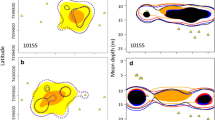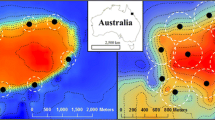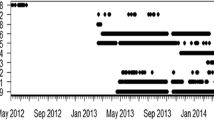Abstract
Movement of fishes defines the distribution and abundance of populations and occurs on a range of spatial and temporal scales. To successfully parameterise assessments and design management strategies for exploited fish populations, knowledge and consideration of their movement patterns are essential. Since the efficacy of management approaches vary depending on the sedentary or mobile nature of the target species, presence, space use and depth utilisation were examined to understand the movement patterns of redthroat emperor Lethrinus miniatus. Sixty individuals were monitored for up to 12 months in an acoustic array comprising three coral reefs, and variation in space use and movement patterns was observed among 26 individuals. Half of the individuals were recorded only in proximity of one receiver along the reef edge, while the other half were detected at multiple receivers and used horizontal areas of approximately 4 km2. Periods of non-detection and lower detection frequency at night (χ 21 = 342.157, P < 0.001) indicated individuals may move away from the monitored reef edge to the adjacent sandy habitat, but most movements outside the array remain unknown. Long-distance movement was recorded for one individual, recaptured ~160 km from the release location. Generally, no trends in depth use were apparent, L. miniatus inhabited a variety of depths, which were not related to individual size or time of day, yet some effect of month was evident. Variation in movement among adult L. miniatus indicates that while some individuals undergo broader-scale movement, spatial closures that cover individual reefs (>4 km2) could provide protection from fishing for the proportion of the population that displayed high site fidelity and moderate-sized activity spaces (over a period of up to 12 months).







Similar content being viewed by others
References
Afonso P, Fontes J, Holland KN, Santos RS (2009) Multi-scale patterns of habitat use in a highly mobile reef fish, the white trevally Pseudocaranx dentex, and their implications for marine reserve design. Mar Ecol Prog Ser 381:273–286
Appeldoorn RS, Aguilar-Perera A, Bouwmeester BLK, Dennis GD, Hill RL, Merten W, Recksiek CW, Williams SJ (2009) Movement of fishes (Grunts: Haemulidae) across the coral reef seascape: a review of scales, patterns and processes. Caribb J Sci 45(2–3):304–316
Bellquist LF, Lowe CG, Caselle JE (2008) Fine-scale movement patterns, site fidelity, and habitat selection of ocean whitefish (Caulolatilus princeps). Fish Res 91:325–335
Brill RW, Lutcavage ML (2001) Understanding environmental influences on movements and depth distributions of tunas and billfishes can significantly improve population assessments. Am Fish Soc Symp 25:179–198
Brill RW, Block BA, Boggs CH, Bigelow KA, Freund EV, Marcinek DJ (1999) Horizontal movements and depth distribution of large adult yellowfin tuna (Thunnus albacares) near the Hawaiian Islands, recorded using ultrasonic telemetry: implications for the physiological ecology of pelagic fishes. Mar Biol 133(3):395–408
Bunt CM, Kingsford MJ (2014) Movement, habitat utilization and behaviour of coral trout Plectropomus leopardus during and after the reproductive period on the southern Great Barrier Reef. Mar Ecol Prog Ser 496:33–45
Cadrin CX, Secor D (2009) Accounting for spatial population structure in stock assessment: past, present, and future. In: Beamish RJ, Rothschild BJ (eds) The future of fisheries science in North America, vol 31. Fish and fisheries series. Springer, Dordrecht, pp 405–426
Cagua EF, Berumen ML, Tyler EHM (2013) Topography and biological noise determine acoustic detectability on coral reefs. Coral Reefs 32:1123–1134
Calenge C (2006) The package adehabitat for the R software: tool for the analysis of space and habitat use by animals. Ecol Model 197:516–519
Carpenter KE (2001) Lethrinidae. Emperor (emperor snappers). In: Carpenter KE, Niem V (eds) FAO species identification guide for fishery purposes. The living marine resources of the Western Central Pacific. Volume 5. Bony fishes part 3 (Menidae to Pomacentridae). FAO, Rome, pp 3004–3051
Cartamil DP, Lowe CG (2004) Diel movement patterns of ocean sunfish Mola mola off southern California. Mar Ecol Prog Ser 266:245–253
Chapman MR, Kramer DL (2000) Movements of fishes within and among fringing coral reefs in Barbados. Environ Biol Fishes 57:11–24
Chapman BB, Skov C, Hulthén K, Brodersen J, Nilsson PA, Hansson L-A, Brönmark C (2012) Partial migration in fishes: definitions, methodologies and taxonomic distribution. J Fish Biol 81(2):479–499
Chateau O, Wantiez L (2008) Human impacts on residency behaviour of spangled emperor, Lethrinus nebulosus, in a marine protected area, as determined by acoustic telemetry. J Mar Biol Assoc UK 88(4):825–829
Chateau O, Wantiez L (2009) Movement patterns of four coral reef fish species in a fragmented habitat in New Caledonia: implications for the design of marine protected areas. ICES J Mar Sci 66:50–55
Claisse JT, Clark TB, Schumacher BD, McTee SA, Bushnell ME, Callan CK, Laidley CW, Parrish JD (2011) Conventional tagging and acoustic telemetry of a small surgeonfish, Zebrasoma flavescens, in a structurally complex coral reef environment. Environ Biol Fishes 91:185–201
Claydon JAB, McCormick MI, Jones GP (2012) Patterns of migration between feeding and spawning sites in a coral reef surgeonfish. Coral Reefs 31(1):77–87
Currey LM, Williams AJ, Mapstone BD, Davies CR, Carlos G, Welch DJ, Simpfendorfer CA, Ballagh AC, Penny AL, Grandcourt EM, Mapleston AJ, Wiebken AS, Bean K (2013) Comparative biology of tropical Lethrinus species (Emperors): challenges for multi-species management. J Fish Biol 82:764–788
Currey LM, Heupel MR, Simpfendorfer CA, Williams AJ (2014) Inferring movement patterns of a coral reef fish using oxygen and carbon isotopes in otolith carbonate. J Exp Mar Biol Ecol 456:18–25
Duong T (2007) ks: Kernel density estimation and kernel discriminant analysis for multivariate data in R. J Stat Softw 21:1–16
Egli DP, Moy W, Naisilisili W (2010) Fish movement in MPAs on coral reefs in Kubulau, Fiji. Technical report no. 05/10. Wildlife Conservation Society-Fiji, Suva
Eristhee N, Oxenford HA (2001) Home range size and use of space by Bermuda chub Kyphosus sectatrix (L.) in two marine reserves in the Soufriere Marine Management Area, St Lucia, West Indies. J Fish Biol 59(A):129–151
Fisheries Queensland (2013) Coral reef fin fish fishery 2011–12 fishing year report. Department of Agriculture, Fisheries and Forestry, Brisbane
Fitzpatrick BM, Harvey ES, Heyward AJ, Twiggs EJ, Colquhoun J (2012) Habitat specialization in tropical continental shelf demersal fish assemblages. PLoS ONE 7(6):e39634
Fletcher WJ, Santoro K (2013) Status reports of the fisheries and aquatic resources of Western Australia 2012/13: the state of the fisheries. Department of Fisheries, Western Australia, Perth
Friedlander AM, Parrish JD, DeFelice RC (2002) Ecology of the introduced snapper Lutjanus kasmira (Forsskal) in the reef fish assemblage of a Hawaiian bay. J Fish Biol 60:28–48
Godo OR, Hjellvik V, Iversen SA, Slotte A, Tenningen E, Torkelsen T (2004) Behaviour of mackerel schools during summer feeding migration in the Norwegian Sea, as observed from fishing vessel sonars. ICES J Mar Sci 61(7):1093–1099
Grüss A, Kaplan DM, Guénette S, Roberts CM, Botsford LW (2011) Consequences of adult and juvenile movement for marine protected areas. Biol Conserv 144:692–702
Heupel MR, Simpfendorfer CA (2014) Importance of environmental and biological drivers in the presence and space use of a reef-associated shark. Mar Ecol Prog Ser 496:47–57
Heupel MR, Simpfendorfer CA, Heuter RE (2004) Estimation of shark home ranges using passive monitoring techniques. Environ Biol Fishes 71:135–142
Heupel MR, Semmens JM, Hobday AJ (2006) Automated acoustic tracking of animals: scales, design and deployment of listening station arrays. Mar Freshw Res 57:1–13
Hobson ES (1973) Diel feeding migrations in tropical reef fishes. Helgolainder wiss. Meeresunters 24:361–370
Holland KN, Brill RW, Chang RKC (1990) Horizontal and vertical movements of yellowfin and bigeye tuna associated with fish aggregating devices. Fish Bull 88:493–507
Holland KN, Peterson JD, Lowe CG, Wetherbee BM (1993) Movements, distribution and growth rates of the white goatfish Mulloides flavolineatus in a fisheries conservation zone. Bull Mar Sci 52:982–992
Holland KN, Lowe CG, Wetherbee BM (1996) Movements and dispersal patterns of blue trevally (Caranx melampygus) in a fisheries conservation zone. Fish Res 25(3–4):279–292
Jones GP (1991) Post recruitment processes in the ecology of coral reef fish populations. In: Sale PF (ed) The ecology of fishes on coral reefs. Academic Press, San Diego, pp 294–328
Kalish JM (1991) Oxygen and carbon stable isotopes in the otoliths of wild and laboratory-reared Australian salmon (Arripis trutta). Mar Biol 110:37–47
Kaunda-Arara B, Rose GA (2004a) Out-migration of tagged fishes from marine reef national parks to fisheries in coastal Kenya. Environ Biol Fishes 70(4):363–372
Kaunda-Arara B, Rose GA (2004b) Long-distance movements of coral reef fishes. Coral Reefs 23:410–412
Kramer DL, Chapman MR (1999) Implications of fish home range size and relocation for marine reserve function. Environ Biol Fishes 55(1):65–79
Marshell A, Mills JS, Rhodes KL, McIlwain JL (2011) Passive acoustic telemetry reveals highly variable home range and movement patterns among unicornfish within a marine reserve. Coral Reefs 30(3):631–642
Mazeroll AI, Montgomery WL (1998) Daily migrations of a coral reef fish in the Red Sea (Gulf of Aqaba, Israel): initiation and orientation. Copeia 4:893–905
Meyer CG, Papastamatiou YP, Clark TB (2010) Differential movement patterns and site fidelity among trophic groups of reef fishes in a Hawaiian marine protected area. Mar Biol 157(7):1499–1511
Musyl MK, Brill RW, Boggs CH, Curran DS, Kazama TK, Seki MP (2003) Vertical movements of bigeye tuna (Thunnus obesus) associated with islands, buoys, and seamounts near the main Hawaiian Islands from archival tagging data. Fish Oceanogr 12(3):152–169
Nanami A, Yamada H (2009) Site fidelity, size, and spatial arrangement of daytime home range of thumbprint emperor Lethrinus harak (Lethrinidae). Fish Sci 75(5):1109–1116
Newman SJ, Williams DM (1996) Variation in reef associated assemblages of the Lutjanidae and Lethrinidae at different distances offshore in the central Great Barrier Reef. Environ Biol Fishes 46(2):123–138
O’Toole AC, Danylchuk AJ, Goldberg TL, Suski CD, Philipp DP, Brooks E, Cooke SJ (2011) Spatial ecology and residency patterns of adult great barracuda (Sphyraena barracuda) in coastal waters of the Bahamas. Mar Biol 158(10):2227
Palumbi SR (2004) Marine reserves and ocean neighbourhoods: the spatial scale of marine populations and their management. Annu Rev Environ and Resour 29(1):31–68
Payne NL, Gillanders BM, Webber DM, Semmens JM (2010) Interpreting diel activity patterns from acoustic telemetry: the need for controls. Mar Ecol Prog Ser 419:295–301
Pinheiro J, Bates D, DebRoy S, Sarkar D, R Development Core Team (2013) nlme: Linear and nonlinear mixed effects models. R package version 3.1-109
Pittman SJ, McAlpine CA (2001) Movements of marine fish and decapod crustaceans: process, theory and application. Adv Mar Biol 44:205–294
Quinn TP, Brodeur RD (1991) Intra-specific variations in the movement patterns of marine animals. Am Zool 31(1):231–241
Sale PF (1991) The ecology of fishes on coral reefs. Academic Press, New York
Simpfendorfer CA, Heupel MR, Hueter RE (2002) Estimation of short-term centers of activity from an array of omnidirectional hydrophones and its use in studying animal movements. Can J Fish Aquat Sci 59:23–32
Simpfendorfer CA, Heupel MR, Collins AB (2008) Variation in the performance of acoustic receivers and its implication for positioning algorithms in a riverine setting. Can J Fish Aquat Sci 65:482–492
Starr RM, Heine JN, Felton JM, Cailliet GM (2002) Movements of bocaccio (Sebastes paucispinis) and greenspotted (S. chlorostictus) rockfishes in a Monterey submarine canyon: implications for the design of marine reserves. Fish Bull 100(2):324–338
Taylor BM, Mills JS (2013) Movement and spawning migration patterns suggest small marine reserves can offer adequate protection for exploited emperor fishes. Coral Reefs 32(4):1077–1087
Welsh JQ, Fox RJ, Webber DM, Bellwood DR (2012) Performance of remote acoustic receivers within a coral reef habitat: implications for array design. Coral Reefs 31(3):693–702
Williams AJ, Little LR, Punt AE, Mapstone BD, Davies CR, Heupel MR (2010) Exploring movement patterns of an exploited coral reef fish when tagging data are limited. Mar Ecol Prog Ser 405:87–99
Zeller DC (1997) Home range and activity patterns of the coral trout Plectropomus leopardus (Serranidae). Mar Ecol Prog Ser 154:65–77
Acknowledgments
We thank the staff and students of the Fishing and Fisheries Research Group for assisting with this project, particularly A. Tobin, F. de Faria, S. Moore, E. Lédée, S. Munroe, V. Udyawer, M. Espinoza and J. Matley. Infrastructure and field support provided by the Australian Animal Tagging and Monitoring System facility of the Integrated Marine Observing System and the Australian Institute of Marine Science was greatly appreciated. Map data was provided by the Commonwealth of Australia (Great Barrier Reef Marine Park Authority), Google™earth and DigitalGlobe. Funding for this research was provided by the Australian Research Council awarded to M.R.H. Additional research funding was granted to L.M.C. from James Cook University (JCU) School of Earth and Environmental Sciences (SEES). L.M.C. was also supported by an AIMS@JCU Postgraduate Research Scholarship and stipend. We also thank the editor and two anonymous reviewers for their constructive comments on this manuscript. All research activities were conducted under GBRMPA permit numbers G10/33754.1 and G10/33758.1 and Queensland Department of Agriculture, Fisheries and Forestry permit number 144482. Treatment of all animals was conducted under ethical guidelines approved by JCU animal ethics number A1566.
Author information
Authors and Affiliations
Corresponding author
Additional information
Communicated by J. D. R. Houghton.
Rights and permissions
About this article
Cite this article
Currey, L.M., Heupel, M.R., Simpfendorfer, C.A. et al. Sedentary or mobile? Variability in space and depth use of an exploited coral reef fish. Mar Biol 161, 2155–2166 (2014). https://doi.org/10.1007/s00227-014-2497-4
Received:
Accepted:
Published:
Issue Date:
DOI: https://doi.org/10.1007/s00227-014-2497-4




